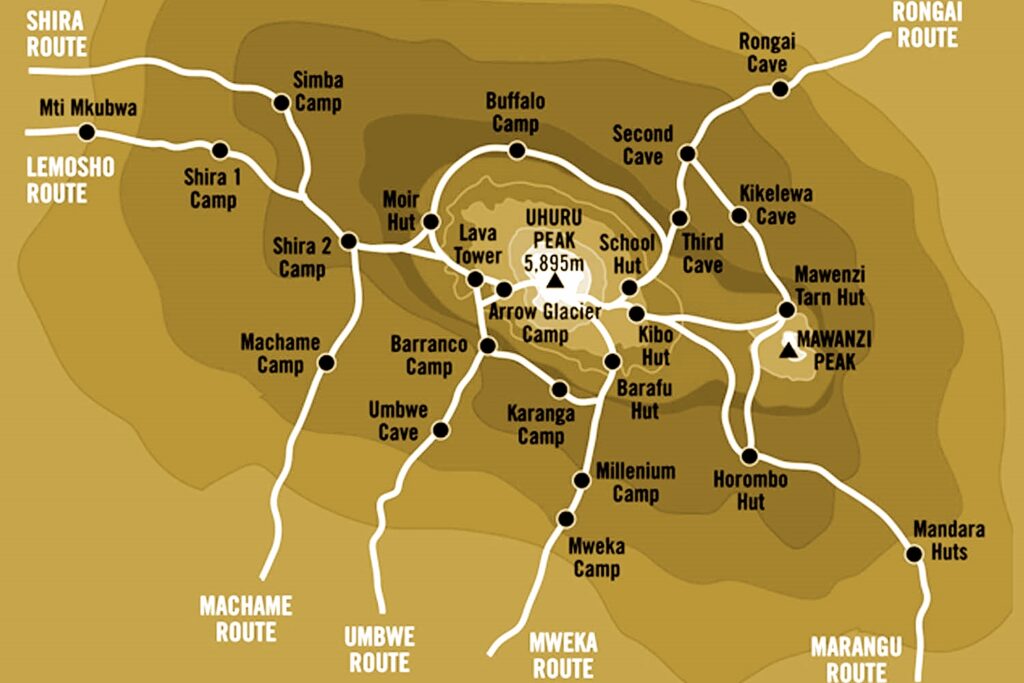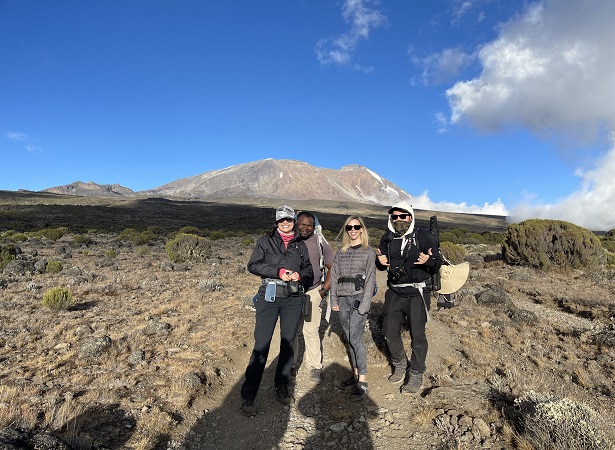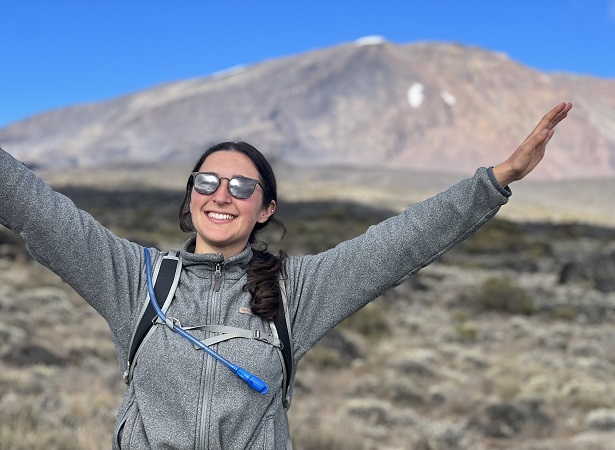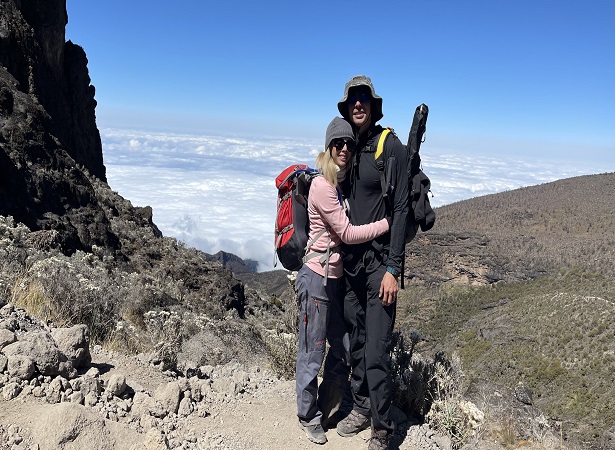Welcome to Kilimanjaro Climbing Guide
Mount Kilimanjaro, the highest peak in Africa and the highest freestanding mountain in the world, is a dream destination for adventurous souls seeking to conquer its majestic summit. Standing at 5,895 meters (19,341 feet) above sea level, this iconic mountain offers a thrilling and challenging climbing experience.

You’re Step by Step Guide to a Kilimanjaro Climbing Expedition
Local crew expedition will provide you with every aspect of a Kilimanjaro climbing expedition. From choosing the right route to understanding the necessary fitness and acclimatization strategies. We’ll offer valuable tips, expert advice, and real-life experiences to help you prepare mentally and physically for this extraordinary journey. We understand the concerns that come with planning a Kilimanjaro climb—the physical endurance required, the mental resilience needed, and the desire for a safe and authentic experience
Tackling the majestic Mount Kilimanjaro is an adventure of a lifetime. By following this step-by-step guide, you’ll be well-equipped to conquer the challenges and make unforgettable memories. Remember, preparation is key from physical fitness to proper gear, ensure you’re ready to face the rugged terrain and changing weather conditions. Throughout your expedition, the help of Local crew expedition experienced guides and porters are essential. They’ll not only assist you in navigating the mountain but also provide valuable insights about the local culture and environment. Our presence will ensure your safety and add to the overall experience. As you take each step towards the summit, savor the awe-inspiring landscapes and embrace the resilience within you.
Book Your Kilimanjaro Expedition Now
Best Selling Kilimanjaro Climbing Packages
Climbing Kilimanjaro is an extraordinary adventure that pushes physical and mental boundaries, offering an experience of a lifetime. From the awe-inspiring landscapes to the personal triumph of reaching the summit, this remarkable journey leaves an indelible mark on every climber. So, if you are seeking a life-changing adventure, set your sights on the Roof of Africa and embark on the unforgettable journey of climbing Kilimanjaro.
- From: $.3200
- From: $.2400
- From: $.2,600
- From: $.2600
- From: $.2400
- From: $.2800
- From: $.2800
- From: $.3,200
- From: $. 1800
- From: $.2000
- From: $.1800
- From: $.2000
Mount Kilimanjaro Climbing Routes
When it comes to embarking on a Kilimanjaro climbing expedition, choosing the right route is crucial for a successful and enjoyable experience. With several routes to choose from, each with its own characteristics and challenges, it’s important to consider various factors before making your decision. There are various routes to choose from when climbing Mount Kilimanjaro, each offering different landscapes, challenges, and experiences.
The Marangu Route is one of the most popular routes for those who want to trek to the top of Mount Kilimanjaro. Also known as the “Coca-Cola Route,” it is the only route that offers hut accommodations and is considered the easiest route. However, this also means that it can be crowded during peak season.
The Machame Route is also known as the “Whiskey Route” and is the most popular trekking route in Tanzania. It is a challenging route but also the most scenic due to the panoramic views of the Shira Plateau and the Western Breach. With its rocky terrain, trekking poles are highly recommended.
Rongai route ascends Mount Kilimanjaro from the north-eastern side of the mountain, along the border between Tanzania and Kenya. The rongai route retains a sense of unspoiled wilderness. The Rongai route is the only route that approaches Kilimanjaro from the north.
The Lemosho Route is the best way to climb Kilimanjaro and experience the breathtaking beauty of the mountain. With its numerous advantages, including scenic views, diverse flora and fauna, and a higher success rate, you can be sure of an unforgettable experience.
Kilimanjaro’s Northern Circuit Route is a remote and beautiful trail, but it’s a challenging trek that requires careful planning and preparation. It is the longest route on Kilimanjaro. It offers amazing scenery, excellent acclimatization, and a quiet trek. This is the reasons we love this Kilimanjaro route!
Proper acclimatization and physical preparation are crucial to reach the summit of Mount Kilimanjaro via the challenging Umbwe Route. The route includes several acclimatization days, and proper preparation will enable climbers to tackle the final ascent towards Stella Point.
The route approaches Mount Kilimanjaro from the west, beginning with a long drive from Moshi to Shira Ridge. The vehicle bypasses the rain forest zone and the hiking trail begins on Shira Ridge. The Shira route crosses the entire Shira Plateau from west to east in a pleasant, relatively flat hike.
Kilimanjaro mountain bike trail itinerary is the new service for summiting Mt Kilimanjaro for active and adventure lovers. The Kilema route is the only route that you can reach to the summit by mountain bike. Our experienced guides have done a sufficient number of successful bike trails to the summit.
Mount Meru(4,566 m) is an active stratovolcano and forms the centrepiece of Arusha National Park in Tanzania. Although the mountain is not as high as Kilimanjaro, it is just as challenging. Known for its beautiful green surroundings and abundant wildlife, Mount Meru is the second highest in Tanzania.
Frequent Asked Questions for Kilimanjaro Climbing
There are six initial approach routes, counter-clockwise from west to east:
1. Lemosho Glades – starting from a remote trailhead and ascending through forest, and heather over two days to reach the western edge of the great Shira plateau. This route continues up either the Northern Circuit, Western Breach or the Machame/Southern Circuit route. Done via the Southern Circuit (most common), it’s the longest distance route to choose on Kilimanjaro. It’s best done 7 or more days.
2. Shira /Morum Barrier – This route starts high (over 12,000’ / 3,500m) but on longer climbs offers the chance of easy/gentle hiking from the start of the climb, as well as avoiding other tourists, especially when choosing the remote northern circuit route. Although a start from Morum Barrier Gate offers the choice to continue on the Southern Circuit, Northern Circuit or Western Breach, it’s best done via the Northern circuit in 8 days (as per our 8-day group trek option). We prefer this route over all others, for its’ wilderness character and low foot-traffic.
3. Machame (Whiskey Route) – by far the most popular route and busiest route overall, usually done in 6 or 7 days via southern circuit and finally ascending to the summit via the east facing Mweka (Barafu Camp) route to the crater rim at Stella Point. It’s also quite pretty and rugged. Best done in 7 days. Very difficult to do in 6 days.
4. Umbwe – The shortest and most direct way to Kilimanjaro’s summit, and this is the most challenging both in terms of terrain and grade. This route is best done via the Western Breach, in 6 or 7 days, but can continue on the Machame/Southern circuit route too.
5. Marangu (Coca-Cola Route) – the original hut route starting at the southeast and passing through thick forest, heather and moorland before crossing the saddle between Mawenzi and Kibo, then up to Gillman’s point before skirting around the south crater rim to Uhuru Peak. Pre-booking and deposits are required on this route (to reserve the huts). From 5+ days, best done in 6 days.
6. Rongai – An approach from the dry northeast (Kenya side), up to the flanks for Mawenzi (the most easterly of Kilimanjaro’s three volcanoes) then on into the great expanse of barren saddle between Mawenzi and Kibo, and finally up to the summit via the Marangu Route. From 5+ days, but best done in 6 or 7 days. The descent route on Rongai is the Marangu Route, which makes for a longer last day than other camping routes.
There is a circuit of routes traversing the Kibo massif in the alpine desert (ranging from about 3,500 to 4,000 m), and from this circuit on upwards there are only three summit route choices.
The Northern Circuit is by far the least used route on Kilimanjaro, and is home to the true wilderness on Kilimanjaro.
The Southern Circuit is essentially the continuation of the popular Machame Route following the east facing Mweka (Barafu Camp) route to the crater rim at Stella Point. This route to the summit receives more than 80% of all summit foot-traffic. Most of the rest of the summit-goers pass via the Marangu Route via Gillman’s point before skirting around the south crater rim to Uhuru Peak.
The Western Breach is the third and last summit route, and gets a tiny percentage of the summit foot traffic, as it’s a steep scramble from camp at 4,900 m (Arrow Glacier Camp) to the crater rim at 5,900m, and is a true alpine-adventure style scrambling route, which includes rock fall risk. We’ve imposed our own restrictions on this route, in order to ensure the group is relatively homogenous and have prior experience with this type of terrain. We provide mountaineering helmets for all participants who ascend the Western Breach.
The best times of year to climb Kilimanjaro for the weather (avoiding rain) are January to early March and July to mid-October. There’s a long, dry winter and a green season with two rainy periods at each end. December, January, February and March are the warmest months, with clear mornings and evenings, and clouds building during the day that occlude the summit in the early afternoon hours. The predictable patterns of weather make it a good time to climb.
The main rainy season lasts from the beginning of April to early June. At this time, dense cloud formations massed over the mountain reduce visibility, and you can expect frequent snowstorms on the summit and heavy rains on the lower slopes.
The longest and driest season runs from mid-June to mid-October. During this time it can be very cold at night. During Kilimanjaro’s “winter,” there is a persistent dripping belt of clouds girdling the whole mountain above the forests and the moorland contour, leaving the summit and a few other distant peaks poking through. Above the clouds, it is usually clear and dry, and this is one of the best times to plan the trek.
In late October, the clouds finally give way to rain, and until the middle of December, the mountain is often shrouded in heavy clouds, with persistent showers from base to summit.
The best months to climb Kilimanjaro are January, February, July, August and September.
Avoid climbing during the April-May heavy rain season, and November (the short rains) if you can. During these times, in order to stay out of the ‘crowds’, it’s best to avoid the Machame Route, and on any route; avoid starting your climb on a Saturday or Sunday (the majority of groups start on these days). Regarding climbing on a full moon, we recommend arranging the summit attempt three to five days AFTER the full moon, for optimal moonlighting the summit trail during the night.
It’s important to pack suitable clothing, including layers for cold weather and rain. Other essentials include a good quality backpack, water bladder, hiking boots, and trekking poles.
Sleeping Gear:
- Sleeping Bag rated 0°F, -15°F
- Sleeping mat : we provide one
- Sleeping bag liner (for extra warmth or for rented sleeping bag)
- Compression sack for sleeping bag
Packs & Bags:
- Waterproof duffel bag 80-100 litres
- Daypack 25-35 litres
- Waterproof pack cover
- Compression sacks or 6-8 waterproof bags
- (Optional) Packing cubes to organize your duffel bag
- Bag lock for duffel bag
Footwear & Trekking Poles
- Hiking boots – waterproof mid-weight
- Running shoes/light hikers (for wearing around camp)
- Gaiters
- 5-6 pairs liner socks (wool or synthetic, no cotton)
- 4-6 pairs thick socks (no cotton!) – thermal socks for summit night
- Spare laces for hiking boots
- Trekking poles
Gloves
- Thin gloves (wool or synthetic, no cotton)
- Thick waterproof gloves or mittens
Clothing: Lower Body
- Underwear (no cotton)
- 1 “Convertibles” or shorts
- 1-2 light-medium weight Base layer
- Hiking pants (no cotton)
- Winter hiking pants
- Waterproof shell pants (recommend size zippers)
Clothing: Upper Body
- Comfortable sports bra (ladies only)
- 1-2 light-weight T-shirts (no cotton)
- 1-2 light weight long-sleeved T-shirts (no cotton)
- 2-3 Light to mid-weight Base Layer
- 1-2 Fleece as insulation layer
- Insulated shell jacket
- Down jacket (approx 750-fill)
- Waterproof shell jacket that fits over all your layers
Headwear
- Brim hat or cap with neck protection
- Warm hat with ear flaps
- Neck gaiter or “Buff” (very versatile)
- Sunglasses (rated 100% UV protection)
- Head-torch (don’t forget spare batteries)
Water & Snacks
- 2-3 liter hydration bladder (Platypus or Camelbak or similar)
- 1-2 One-liter wide-mouth water bottle (Nalgene or similar)
- Electrolyte/Sports drink powdered formula for adding to your water
- Snacks: Energy bars of your preference – plan for 2-4 per day
- Water purification tablets or filter pen (we provide boiled/filtered water)
Personal Health & Comfort
- Toiletries: toothbrush & paste, hairbrush/comb, foot powder, hand cream, deodorant,
- “Baby-wipes” and anti-bacterial, hand-sanitizer wipes
- Any regular medication you are taking
- Anti-bacterial hand-sanitizer gel such as Purell
- Fingernail brush
- Nail clippers
- Ear plugs
- Sunscreen SPF 40+
- Small microfiber quick-dry towel
- Pee-bottle for night time calls of nature
- Small torch
- Headtorch
- Pocket knife (Swiss Army Knife or “Leatherman”)
- Spare contact lenses/glasses
- Toilet paper (1-2 Take out the cardboard center for easier packing)
- Camera/phone/iPod/Kindle
- Spare batteries
Personal first-aid Kit
- Blister plasters – different shapes and sizes
- Antibiotic cream or ointment
- Band-Aid/Elastoplast for minor cuts and scrapes
- Ibuprofen/Paracetamol – over the counter pain relief
- Skin healing ointment such as Aquaphor
- Immodium for diarrhea
- 4 Anti-nausea medication
- Any prescription medications
- Diamox (if using)
Ladies Only:
- During menstrual period, plan to change your tampon or pad 3-4 times daily
- Ziplock bags for used tampons/pads (these must be carried off the mountain)
- Anti-bacterial hand sanitizer – clean hands regularly
- “Baby wipes” or heavy-duty wipes
- Pee funnel: if you’ve ever wanted to pee standing up, now’s your chance!
Training and preparation for climbing Kilimanjaro, the highest peak in Africa, are essential to ensure a safe and successful expedition. Here are some key aspects to consider:
- Physical Fitness: Kilimanjaro is a challenging climb, so building your physical fitness is crucial. Focus on cardiovascular exercises such as running, hiking, or cycling to improve your endurance. Additionally, include strength training exercises to strengthen your core, lower body, and upper body muscles.
- Hiking and Altitude Experience: Prior experience with hiking and exposure to higher altitudes is highly recommended. This will familiarize you with long hikes, varied terrains, and acclimatization to oxygen-deprived environments. Start with smaller peaks and gradually increase the difficulty to prepare yourself mentally and physically.
- Mountaineering Skills: Although Kilimanjaro does not require technical climbing skills, basic mountaineering skills like using crampons, wearing and adjusting a harness, and using an ice ax can come in handy. Familiarize yourself with these techniques through courses or practical training programs.
- Gear and Clothing: Invest in proper gear and clothing suitable for hiking in various climatic conditions. This includes thermal base layers, waterproof outerwear, sturdy hiking boots, warm sleeping bags, hats, gloves, and sunglasses, among other items. Visit outdoor retailers or consult with experienced climbers to ensure you have the appropriate equipment.
- Mental Preparation: Climbing Kilimanjaro is a mentally challenging endeavor. Prepare yourself mentally by visualizing the climb, setting realistic goals, and practicing mindfulness or meditation techniques to manage stress and pressure. Strong determination and positive attitude are crucial during difficult sections of the climb.
- Altitude Sickness Prevention: Altitude sickness is a common concern on Kilimanjaro. To reduce the risk, plan for an appropriate acclimatization schedule, which includes taking regular breaks and ascending gradually. Stay well-hydrated, consume a balanced diet, and avoid excessive physical exertion. Discuss preventive medications like acetazolamide with your doctor.
- Research and Planning: Thoroughly research the different routes up Kilimanjaro to determine which one suits your fitness level, preferences, and time constraints. Consider factors such as scenery, difficulty, and acclimatization profiles. Ensure you have a well-organized itinerary, permits, and necessary logistical support.
Finally, it is highly recommended to hire a reputable and qualified guides from Local crew Expeditions or join a guided expedition. They will provide expertise, support, and ensure your safety throughout the climb. Remember, proper training, preparation, and caution are essential for a successful and memorable Kilimanjaro experience!
To prepare for Kilimanjaro trekking, you need to have proper equipment and be aware of the risks of high altitude and altitude sickness.
Before embarking on a Kilimanjaro climb, it is essential to understand the nature of the climb and how to prepare for it. The trekking can vary from 5 to 10 days, depending on the route chosen, and the climb requires a fair level of physical fitness as well as mental resilience. Before embarking on your adventure, it is crucial to prepare yourself properly. Here are some essential tips to ensure a successful climb:
High Altitude Precautions
As you ascend Kilimanjaro, you’ll be climbing through several different altitude levels. It’s essential to be aware of the potential risk of altitude sickness, which can cause headaches, nausea, and fatigue. To acclimatize to the altitude, experts recommend a slow and steady ascent with rest days in between.
- Take precautions to combat altitude sickness by ascending slowly and acclimatizing.
- Proper Equipment Investing in proper equipment is crucial for a successful summit bid. While some tour companies provide renters with gear, it’s highly recommended to bring your own to ensure the best fit, comfort, and warmth. One of the most important pieces of equipment is your sleeping bag. Make sure to invest in a high-quality one that has a rating of at least -15 °C
- Hydration is Key Staying hydrated on the mountain is critical, and it’s essential to bring a suitable water bottle. One bottle is generally sufficient for the hike, so invest in one that’s durable, easy to hold, and can hold at least two liters of water.
- Preparing for Cold Nights Temperatures on Mount Kilimanjaro can plummet during the night. To stay warm during the colder evenings, make sure you bring essential clothing layers such as thermal underwear, insulated jackets, and woolen hats and gloves.
- Schedule an Extra Day It’s highly advisable to factor in an extra day or two into your schedule, in case of any unforeseen circumstances such as sickness or inclement weather. By scheduling an extra day, you give yourself the best chance of summiting the mountain.
The cost to climb Kilimanjaro depends on a few primary factors:
The Mount Kilimanjaro climbing cost research shows that, there is no cheaper option to Climb Kilimanjaro, although there is wide range of prices charged for climbing Mount Kilimanjaro by different operators, the price ranging from $2,000 to $7,000 per person.
- Group Size
The more people that are in a trekking party, the lower the cost per person. Climbs that have only one or two climbers will have the highest prices as the costs to operate are shared by a small number of people. Not surprisingly, climbs with a dozen or more people will have much lower prices.
- Days on the Mountain
Each day spent on the mountain incurs additional costs in park fees, staff wages, food, and equipment use. Thus, longer routes are more expensive than shorter routes. Route selection also plays a part as some require more personnel, gear and logistical arrangements.
- Level of Service
Kilimanjaro operators can be categorized into three broad price ranges: budget, midrange and luxury. This is the main driver of the huge price disparity between different companies for what seems like the same service. The typical consumer has a hard time differentiating between operators because a company’s website doesn’t tell the whole story.
Conservation Fees – $70 per day per person.
The Kilimanjaro National Park authority collects fees from all visitors in order to fund the upkeep of the park. This includes maintaining the trail, keeping it clean and paying for the rangers. The conservation fee applies for each day (including partial days) you spend inside the park. On an 8 day Lemosho climb, the conservation fees total $560 ($70 x 8 days).
Camping or Hut Fees – $50 to $60 per night per person
This fee is charged for using the campsites and simple huts on the mountain. Huts are only available on the Marangu route. All other routes camping at designated public sites. The hut fees on a 5 day Marangu climb are $240 ($60 x 4 nights). On an 8 day Lemosho climb, the camping fees are $350 ($50 x 7 nights).
Rescue Fees– $20 per person per trip
Rescue fees are charged for the chance the park authority may need to coordinate a rescue. This fee must be paid whether or not you actually require rescue. The cost is $20 per person per trip.
Guide and Porter Entrance Fees – $2 per staff person per trip
All of the staff also must pay park fees to enter. The park entrance fee is $2 per person per trip.
Value-Added Tax – 18% of services
A value-added tax (VAT) is a type of general consumption tax that is placed on goods and services whenever value is added at a stage of production or distribution. The Tanzanian government charges an 18% VAT to Kilimanjaro operators.
Wages, Food and Transportation Costs
After park fees and taxes, the other significant expenses are staff wages, food, and transportation costs.
Local wages amount to around $80-$150 per climber per day (depending on group size). Food costs come out to about $10-$20 per climber per day (includes food for staff). Transportation costs are about $100 per trip depending on the route. There are also costs associated with wear and tear on camping equipment and administrative costs for arranging your climb.























